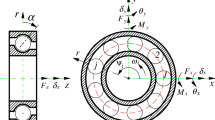Abstract
The paper presents a mathematical model for changing the technical condition of the ball joint of automotive vehicles. A design scheme is proposed, and assumptions and limitations for a mathematical model are determined. During the work, experimental and theoretical studies were carried out. To assess the reliability of the results obtained by theoretical methods, an experimental study was carried out on the developed installation using vibration methods. It has been found that in order to correctly measure vibration acceleration in the ball joint, it is sufficient to use a single vibration sensor «ДH-3» in contact with the test sample parallel to the longitudinal axis of the ball pin. The comparison of curves of vibration acceleration dependence on the value of axial gap during mathematical modeling and experimental study showed that the largest divergence between them does not exceed 10%. This confirms the adequacy of the developed mathematical model of the change in ball joint technical condition and its compliance with the conditions of bench research.
Access this chapter
Tax calculation will be finalised at checkout
Purchases are for personal use only
Similar content being viewed by others
References
Raimpel J (1987) Car chassis: Suspension Elements. Moscow, p 288
Sert E, Boyraz P (2017) Optimization of suspension system and sensitivity analysisfor improvement of stability in a midsize heavy vehicle. Sci Technol, Int J, Eng
Lai CY, Liao WH (2002) Vibration control of a suspension system via amagnetorheological fluid damper. Modal Anal 8(4):527–547
Appleyard M, Wellstead PE (1995) Active suspensions: some background. IEE Proc -Control Theory Appl 142(2):123–128
Kavitha C, Abinav Shankar S, Ashok B, Denis Ashok S, Muhammad Usman Kaisan (2018) Adaptive suspension strategy for a double wishbone suspension through camber and toe optimization. Eng Sci Technol, Int J 21(1):149–158
Karaulin AL (2000) Car design. Chassis, Moscow, p 528
Ossa EA, Palacio CC, Paniagua MA (2011) Failure analysis of a car suspension system ball joint. Eng Fail Anal 18(5):1388–1394
Raimpel J (1989) Car chassis: Suspension structures. Moscow, p 328
Akhmadimov RM, Filkin NM (2009) A new approach in the design of a ball joint of a car suspension. Modern High Technol 4:23–25
Ossa EA, Palacio CC, Paniagua MA (2011) Failure analysis of a car suspension system ball joint. Eng Fail Anal 18:1388–1394
Kargin AA, Kosarov MV, Voinov AA (2008) Analysis of the study of ball joints in a car suspension. Penza State Univers 4:68–70
Akhmadimov RM, Filkin NM (2009) A new approach in the design of a ball joint of a car suspension. Modern High Technology 4:23–25
Mikhailovsky IA, Artyukhin VI (2007) Mastering the production and testing of ball studs of the front suspension of passenger cars from steel 41X1. Mat. 65th science and technology conf. Sat doc. T.1. Magnitogorsk, Moscow, p 23–25
Voskoboinikov YE, Gochakov AV, Kolker AB (2010) Filtration of signals and images: Fourier and Wavelet algorithms. Templan, Novosibirsk, p 195
Bleikhut R (1989) Fast digital signal processing algorithms. Publishing house “Mir”, p 448
Tebekin MD, Katunin AA, Novikov AN (2011) Russian Federation Patent 2483287, 31 May 2011
Zagudillin R (2009) Multisim. Labview, Signal Express, The practice of computer-aided design of electronic devices. Moscow, p 368
Author information
Authors and Affiliations
Corresponding author
Editor information
Editors and Affiliations
Rights and permissions
Copyright information
© 2021 The Editor(s) (if applicable) and The Author(s), under exclusive license to Springer Nature Switzerland AG
About this paper
Cite this paper
Novikov, A.N., Tebekin, M.D., Kolpakova, S.V. (2021). Vibration Diagnostics of Swivel Suspension Elements of Automotive Vehicles. In: Radionov, A.A., Gasiyarov, V.R. (eds) Proceedings of the 6th International Conference on Industrial Engineering (ICIE 2020). ICIE 2021. Lecture Notes in Mechanical Engineering. Springer, Cham. https://doi.org/10.1007/978-3-030-54817-9_82
Download citation
DOI: https://doi.org/10.1007/978-3-030-54817-9_82
Published:
Publisher Name: Springer, Cham
Print ISBN: 978-3-030-54816-2
Online ISBN: 978-3-030-54817-9
eBook Packages: EngineeringEngineering (R0)




